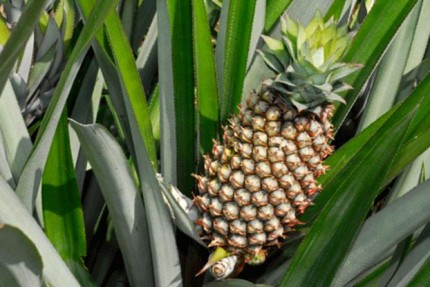Pineapple
 Friday 03 July 2015
Friday 03 July 2015
Other Local Name : Pineapple, Ananas
Botanical Name : Ananas sativus
Family : Bromeliaceae
Main Use : Fruit
Other Uses : 0
Know More
The pineapple is a herbaceous perennial, which grows to 1.0 to 1.5 meters (3.3 to 4.9 ft) tall, although sometimes it can be taller. In appearance, the plant itself has a short, stocky stem with tough, waxy leaves. When creating its fruit, it usually produces up to 200 flowers, although some large-fruited cultivars can exceed this. Once it flowers, the individual fruits of the flowers join together to create what is commonly referred to as a pineapple. After the first fruit is produced, side shoots (called 'suckers' by commercial growers) are produced in the leaf axils of the main stem. These may be removed for propagation, or left to produce additional fruits on the original plant.[5] Commercially, suckers that appear around the base are cultivated. It has 30 or more long, narrow, fleshy, trough-shaped leaves with sharp spines along the margins that are 30 to 100 centimeters (1.0 to 3.3 ft) long, surrounding a thick stem. In the first year of growth, the axis lengthens and thickens, bearing numerous leaves in close spirals. After 12 to 20 months, the stem grows into a spike-like inflorescence up to 15 cm (6 in) long with over 100 spirally arranged, trimerous flowers, each subtended by a bract. Flower colors vary, depending on variety, from lavender, through light purple to red.
The ovaries develop into berries, which coalesce into a large, compact, multiple accessory fruit. The fruit of a pineapple is arranged in two interlocking helices, eight in one direction, thirteen in the other, each being a Fibonacci number.
Pineapple carries out CAM photosynthesis, fixing carbon dioxide at night and storing it as the acid malate and then releasing it during the day, aiding photosynthesis.
The fresh leaf juice is regarded as a powerful anthelmintic, abortifacient and emmenagogue. The unripe fruit is abortifacient, antiscorbutic, digestive, good for influenza; contains digestive enzyme ‘Bromelin’. Juice of the ripe fruit is diuretic, diaphoretic and aperient. In Cambodia, the fruits and roots are considered diuretic; given in blenorrhagia and renal lithiasis.
Leaves and unripe fruits contain sterols and triterpenes, ergosterol peroxide, stigmastene-diol, ß-sitosterol, campesterol, stigmasterol and campestanol. Leaves and crown of fruits contain 5-hydroxytryptamine and a steroid triterpene. Stems contain a proteolytic enzyme bromelin, starch, a trihydroxy terpenoid carboxylic acid, ananasic acid and glyceryl esters of caffeic and coumaric acids. Fruit also contains polyphenols, phenolic acids, ascorbic and other fruit acids, vitamins A and C and volatile flavouring constituents (Ghani, 2003)